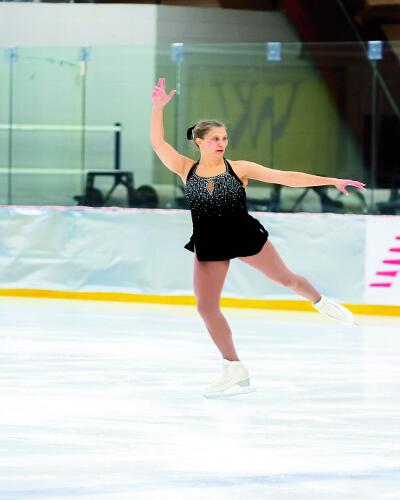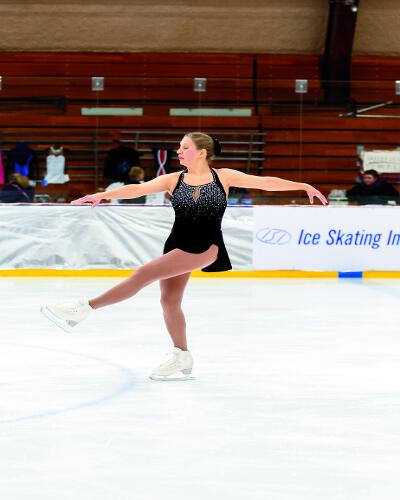While watching her daughter skate, an economics professor decided to get back in the rink herself.
By Katherine Duke '05
[Skating] As she sat in the cold outside the rink in North Adams, Mass., watching her then-9-year- old daughter, Maia, practice figure skating, Lara Shore- Sheppard ’91 had three thoughts: “I could do that.
I used to do that. I want to do that again.” A year later, she brought home a bronze medal from the Bay State Games.

Shore-Sheppard figure-skated competitively from third grade until midway through high school. Then, deciding the sport was too expensive and time-consuming, she gave it up. Only occasionally during her years at Amherst did she make use of Orr Rink.
She found a coach, Cheri Daub, who was close to her in age and therefore familiar with the kind ofBut, decades later, her daugh- ter’s foray onto the ice inspired Shore-Sheppard to follow suit. She rejoined the U.S. Figure Skating Association in 2014.
skating she’d done in the 1980s. Back then, a skater would do “both freestyle, which is what you might have seen on the Olym- pics—jumping and spinning in a program—and then you also did figures,” Shore-Sheppard says, “tracing, very slowly, 8’s or other shapes onto the ice.” In the inter- vening years, the USFSA had re- placed figures with “moves in the field,” a type of skating focused on “strength and flow” and “being able to do different kinds of turns at high or low speeds.”
And,of course,Shore-Sheppard’s own body has changed over time. “When you’re over 40, and you’re trying to do these things that involve landing with bent knees on a hard surface, it’s tough on the knees and the hips,” she says. Practicing more than three times a week can get painful. Fortunately, the skates themselves have also changed: her new ones are made of lightweight composite material, with shorter blades.

Shore-Sheppard—a professor of economics at Williams—worked with Daub to prepare a routine for the Bay State Games, which took place Feb. 20–22 at the Wil- liams ice rink. She competed in the Adult Silver category against five other women, one of whom was 20 years her junior. “I literally could have been her mom,” she says. “So that’s what I told myself when she beat me: ‘OK, you’re competing against your kid.’”
Shore-Sheppard’s actual kids— Maia and 13-year-old Ethan— watched her win the bronze, as did her husband, Tony Sheppard ’91, a music professor at Williams. She’d like to skate again in next year’s Bay State Games and in other competitions, particularly ones “where all the 40-year-olds compete against each other, and they don’t compete against the 20-year-olds.”
In the meantime, she’s relearn- ing how to do an axel jump, and she’s testing her way up through the skill levels of “moves in the field.” She says, “It’s one of the things that I like about coming back: there’s new stuff to learn that I couldn’t have learned when I was a kid.”